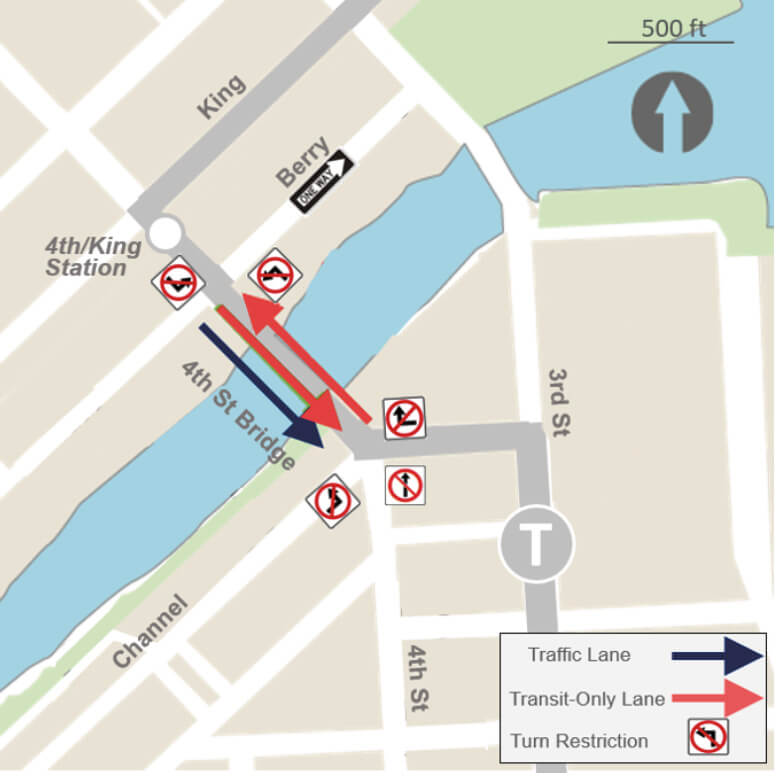
As the San Francisco Municipal Transportation Agency (SFMTA) prepares for the return of T-Third Street Muni Metro service, the agency plans to implement temporary emergency transit lanes in both directions over the Fourth Street Bridge this month. The idea, which drew a barrage of public comment from an estimated 60 attendees of a virtual community meeting SFTMA hosted in December, would address a bottleneck between Berry and Channel streets that causes systemwide delays to T-Third service by enabling streetcars to move across the bridge without getting stuck in traffic. SFMTA identified public health, equity and economic recovery as other reasons for the emergency transit lanes; more efficient transit reduces COVID-19 transmission risks for people with the fewest travel choices.
General traffic would no longer be permitted northbound between Berry and Channel streets. The single northbound lane now shared by streetcars and other vehicles would be repurposed for transit and taxis only, with bicycles and paratransit vehicles permitted. Going south, the middle lane with streetcar tracks would be dedicated to transit and taxis. The southbound curbside lane would remain open for general traffic.
Additional restrictions would include no left turn onto the bridge whilst heading east; no right turn onto the bridge westward bound from Channel Street; no left turn onto Berry from Fourth Street, including by southbound traffic onto the one-way 100 block of Berry Street. Northbound traffic on Fourth Street would be rerouted onto eastbound or westbound Channel Street.
On the Fourth Street Bridge, the temporary emergency transit lane would be striped with white paint and “Muni/Taxi Only” stenciling and signage. Nearby routes for general traffic heading north from Mission Bay towards South-of-Market include Third and Seventh streets. No changes to the Third Street Bridge two-way traffic are planned.
Public reaction ranged from supportive to skeptical. San Francisco Transit Riders Union members strongly favored the plan. Mission Bay residents and those who work in the area suggested that the plan would trigger vastly increased traffic congestion from Channel Street to the Mission Bay Drive traffic circle, back onto Berry Street at the Caltrain crossing. It’d make the 100 block of Berry – where there are residential buildings and patients need access to University of California, San Francisco Department of Radiology and Biomedical Imaging, a China Basin building tenant – inaccessible. Several speakers suggested converting the one-way block of Berry between Third and Fourth streets into a two-way street.
One Mission Bay residents pointed out that driving to South-of-Market or the Financial District would require a circuitous route to head north, unable to turn left out of their driveway onto Channel Street and travel to Third Street because a cement curb prevents vehicles from crossing the streetcar tracks, forcing them onto Fourth Street. They’d then have to turn southbound onto Fourth Street, left at Mission Rock Street, and left again before heading north over the Third Street Bridge.
Replying to The View, SFTMA’s media relations staff stated that the No Left Turn from southbound Fourth Street onto the 100 block of Berry is a “delay reduction measure.” Vehicles turning left at this location must cross the T-Third tracks, which can postpone trains. The agency is analyzing alternatives to allowing vehicles onto the 100 block of Berry, as well as whether changes could be made to Mission Bay Drive at the Caltrain tracks, where residents have requested a Right Turn Only lane onto Berry. Traffic rerouting would include posting new signs to help drivers understand the changes and choose directions; sign plan specifics weren’t available at press time.
The SFMTA Board of Directors is expected to approve the project as a temporary measure to begin as early as January 2021. The emergency transit lane would be removed within 120 days after the City’s emergency health order is lifted unless there’s a public process to make them permanent.

